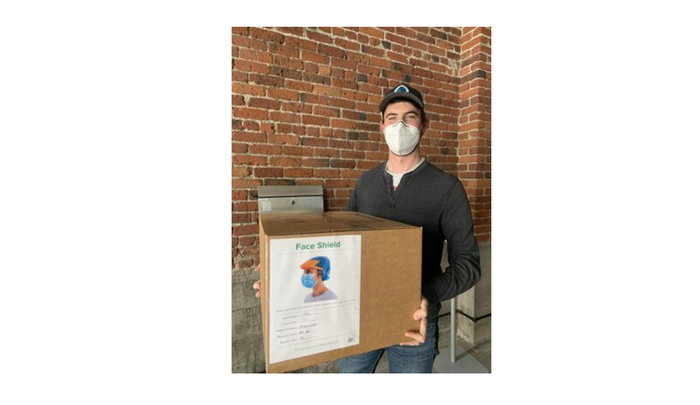Here are 7 tips to make your pandemic project meaningful.
June 3, 2020

Medical device development consists of deliberate market strategy, exhaustive plans, iterative test cycles, and methodical documentation. So how should we respond to an unplanned emergency shortage? The challenge can inspire but also overwhelm and paralyze. Like many vendors involved in the design or manufacturing of medical products, our team at Product Creation Studio became part of an effort to fill the short term need for personal protective equipment (PPE) during the COVID-19 pandemic. Here are some takeaways from that experience that might be useful to keep your emergent development program going.
1. Take the first step.
Turtles demonstrate a visceral survival technique in the face of crisis: pull back and wait it out. In fact, this is what public health authorities seemed to suggest as the best course. I know my initial activities in mid-March focused on home projects and triage for personal and business finances. Of course, I wanted to help the cause in the fight against coronavirus, but what is an engineer to do when stuck at home?
Getting connected with others who are already in motion on a project can be a powerful antidote to this turtle effect. As I answered texts and emails from groups that wanted to address the ventilator or PPE shortages, I realized that I could and should dedicate some headspace to these efforts. My experiences and my network were relevant, so sharing strategy, contacts, and ideas could be valuable without being a burdensome task. As with many projects, constructive collaboration may encourage you to contribute more than you originally bargained for, but you do it willingly.
2. Keep the energy flowing.
I remember when Kickstarter began to make news and we were amazed at the examples of funds raised for some product idea or another. It was evidence that society has pent up potential energy for meaningful innovations. Kickstarter offered an outlet and converted that potential into significant monetary donations.
When our CEO, Cameron Smith, made the decision to start producing face shields, it offered an outlet for our employees to “fight” COVID-19 in a tangible way. We were overwhelmed to have unquestioned participation from the team, including former and currently furloughed employees. The 3D printers in home and office were tuned up and running and within days we had hundreds of parts coming in for assembly.
I can trace a long chain of contributors and motivators that funneled a river of potential energy for the face shield effort. For example David Desmarais and Ilia Timonin, engineers from Product Creation Studio, jumped in to organize the materials and procurement and assembly processes to produce face shield kits. The open-source Prusa face shield designers and participants; a worldwide effort to use 3D printing for good. Tim Prestero and his team at Design that Matters, which adapted the Prusa design to better meet the needs of frontline healthcare workers. Elizabeth Cross Nichol and Dr. Graham Nichol, who provided regulatory guidance and rapid clinical feedback for Tim’s effort. Maren Nelson, our quality management representative, who put me in touch with Elizabeth and Tim. At each step there were people who recognized the need and saw how their skills and connections might contribute to keep the energy flowing. Some dedicated weeks of work, some typed a text or email, and some just briefly communicated a decision. But the players all found a way to be a conduit for the human enthusiasm to help.
3. Be diplomatic.
Have you noticed how a harshly worded text or email, unintentional though it may be, reduces your desire to respond in a constructive way? Witness many online comment strings. We invented manners and diplomacy to encourage human collaboration and avoid corrosive conflict.
Unless you are the genius ready to invent, test, and manufacture the perfect vaccine alone in your lab, you need to work with others to make real progress. Don’t let impatient or terse comments drive away the contributions of others. Their enthusiastic support might be critical to team success at some point.
4. Stick to your knitting.
I’m not sure I want to hear “You do you” another time, but the essence of the phrase fits our crisis needs. If we need a diagnostic breakthrough, should we look to a team of lawyers, disgruntled by the pace of progress? They might pick up some biochemistry books and start mixing reagents over the kitchen sink, but society might be better served if they contribute some thinking on how to manage liability during the time of EUAs or ways to speed contracts between laboratory collaborators.
We want the best diagnostic developers developing and the best lawyers lawyering. While one specialty may feel more important, it is likely that each can contribute meaningfully at given points along the way.
Nicholas Loebel, CTO of Ondine Biomedical Inc., admitted this in a recent conversation with me. Early in the pandemic, Nick recognized the ventilator shortage and began to design intelligent manifolds to allow one vent to serve multiple patients in an adaptive way. He and his team were capable of learning the ropes of ventilatory equipment—their photodynamic disinfection technology had applications there. But he realized that it would be an uphill battle, whereas Ondine’s core technology might emerge as prophylactic to reduce the spread of SARS-CoV-2 in healthcare settings. To contribute in a crisis, do what you are best at and help others do the same.
5. Abbreviate, but don’t skip steps.
Design thinking demands that we get in sync with the users to understand their challenges. Projectile vomit may not have been on his original list of concerns for their face shield, but Tim Prestero and team learned that this was a real concern with which healthcare workers dealt.
While it may seem that there is no time to test, getting feedback from real users and making design changes in response is crucial to effective product design. Tim put his design modifications in front of healthcare workers at University of Washington Medicine working with Graham Nichol, MD, to conduct the observational research. Product Creation Studio engineer Adam Smith made further modifications and worked with Zana Patrick Desgranges, MD, PhD, FACP of Swedish Hospital to validate with representative users there. In times of crisis, we found people and facilities ready to accelerate this feedback loop. So, don’t skip the validation step.

Above: Image courtesy of Product Creation Studio
6. Triage your regulatory approach.
Emergency Use Authorizations (EUA) don’t excuse us from reasonable processes to reduce risks to users. That’s what Elizabeth Cross Nichol kept in mind while helping Tim Prestero from Design that Matters and the local printer community navigate a shifting regulatory landscape in the face of massive PPE shortages. While the EUAs lowered the requirements, Elizabeth guided developers to do a reasonable amount of process like identifying the intended use and end user that impacts materials testing (for example, flammability) and labeling requirements. This resulted in a set of instructions for use to accompany each face shield kit, something that might have been skipped by a team of engineers.
7. Don’t be afraid of change.
Making changes to a medical device can be a big deal. Changes often require re-testing of the materials and performance to demonstrate that essential function and safety are preserved. This can lead to a reluctance to make any changes at all. But, responding to an emergent need may require repurposing equipment for a new role or the integration of feedback (user or production) into the design in real time. It’s important to keep in mind that the core functionality must be preserved but the means to attain that may change.
If you are a design engineer for a class II product, you are familiar with the competing need to innovate and demonstrate equivalence to a predicate. Early in my device career, I recall concern that equivalence would wring out all opportunities to be creative on a skin care therapeutic and that the next-generation product seemed destined to be exactly like the original. But a review of the essential functions and critical risk mitigations highlighted the handful of features that were untouchable. We were freed to make the new product look and feel very different while equivalent therapy was maintained. In fact, we were even able to change the design of the core function (a temperature-controlled heater) to significantly reduce the cost of goods.
Similarly, on our recent face shield effort, Product Creation Studio engineer Adam Smith wanted to reduce long print times to better utilize the limited number of printers and available printing hours for some home shops (that printer in the bedroom would keep me awake, too). He reworked the forehead protector, a feature that Tim and the clinical test team had demonstrated was non-negotiable, to be a two-piece assembly. This resulted in shorter print times with at least equivalent protective functionality. It also was close enough to the original design so that the instructions for use did not need to be modified. This allowed for a running production change, reducing our print bottleneck.
Conclusion
Medical device specialists want to help, but responding to pandemic shortages can be complicated. These takeaways come from our experience with building PPE, but they apply to any collaborative rapid response project. Use these tips as a framework to get you and your team on the path to meaningful progress.
About the Author(s)
You May Also Like


